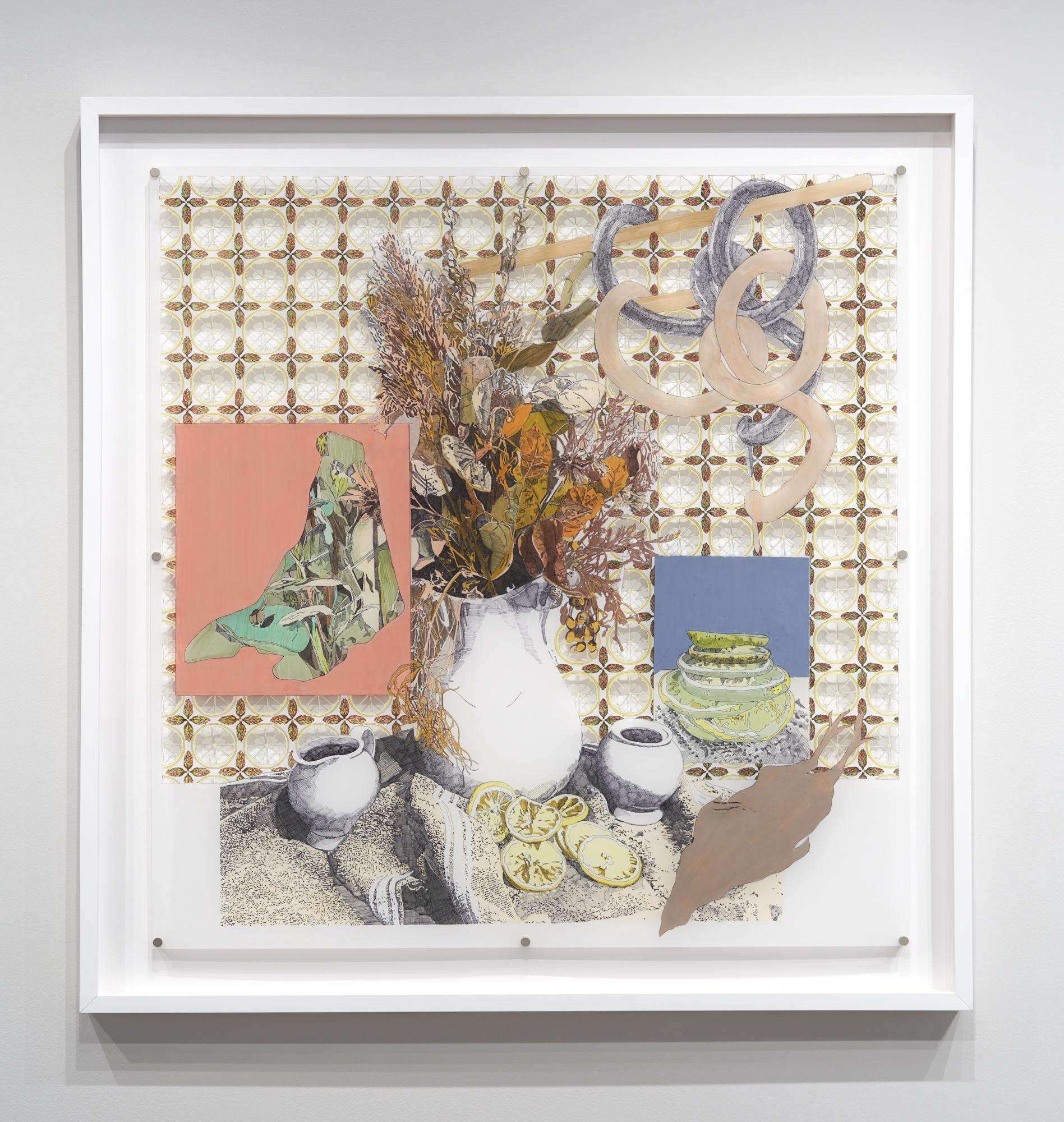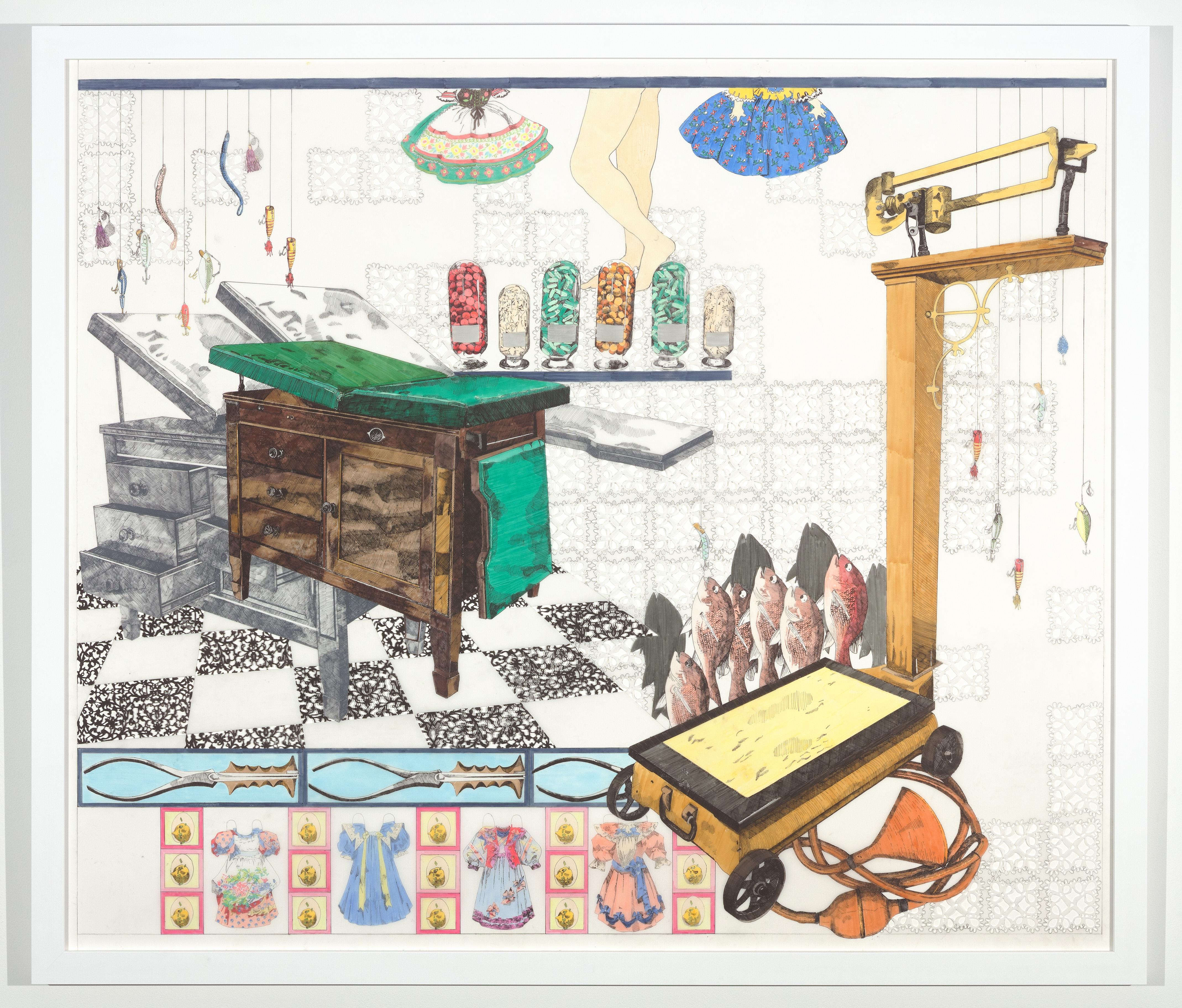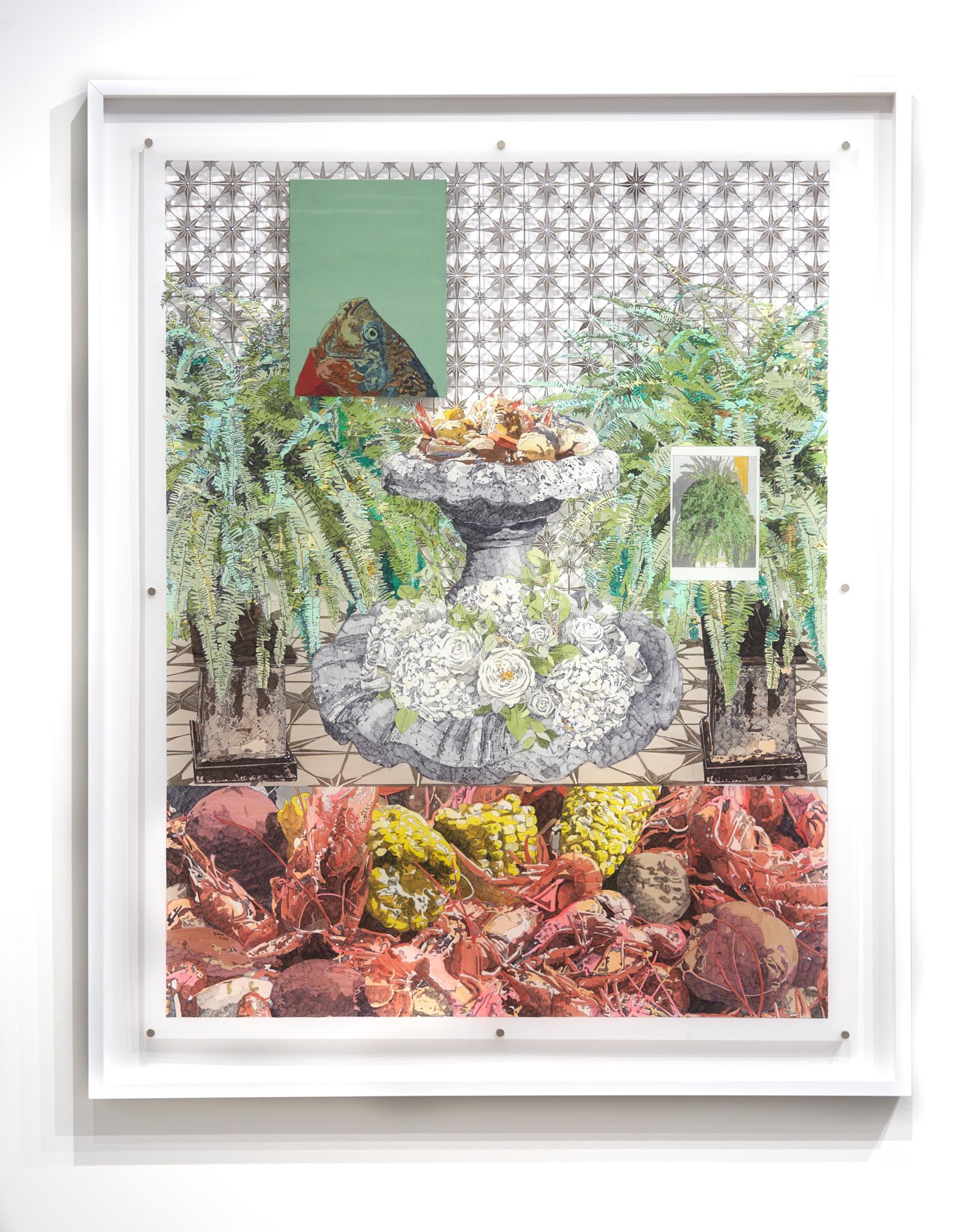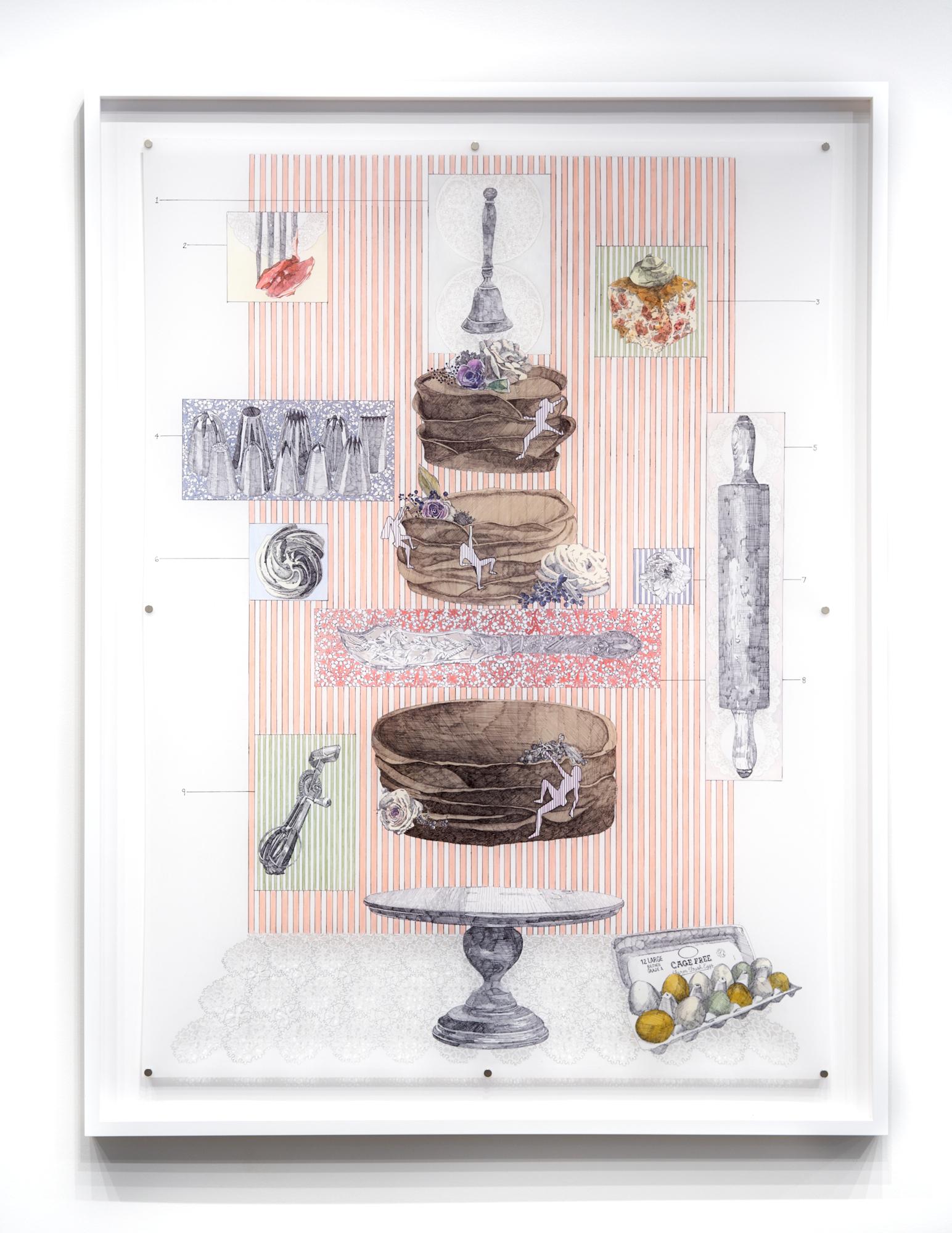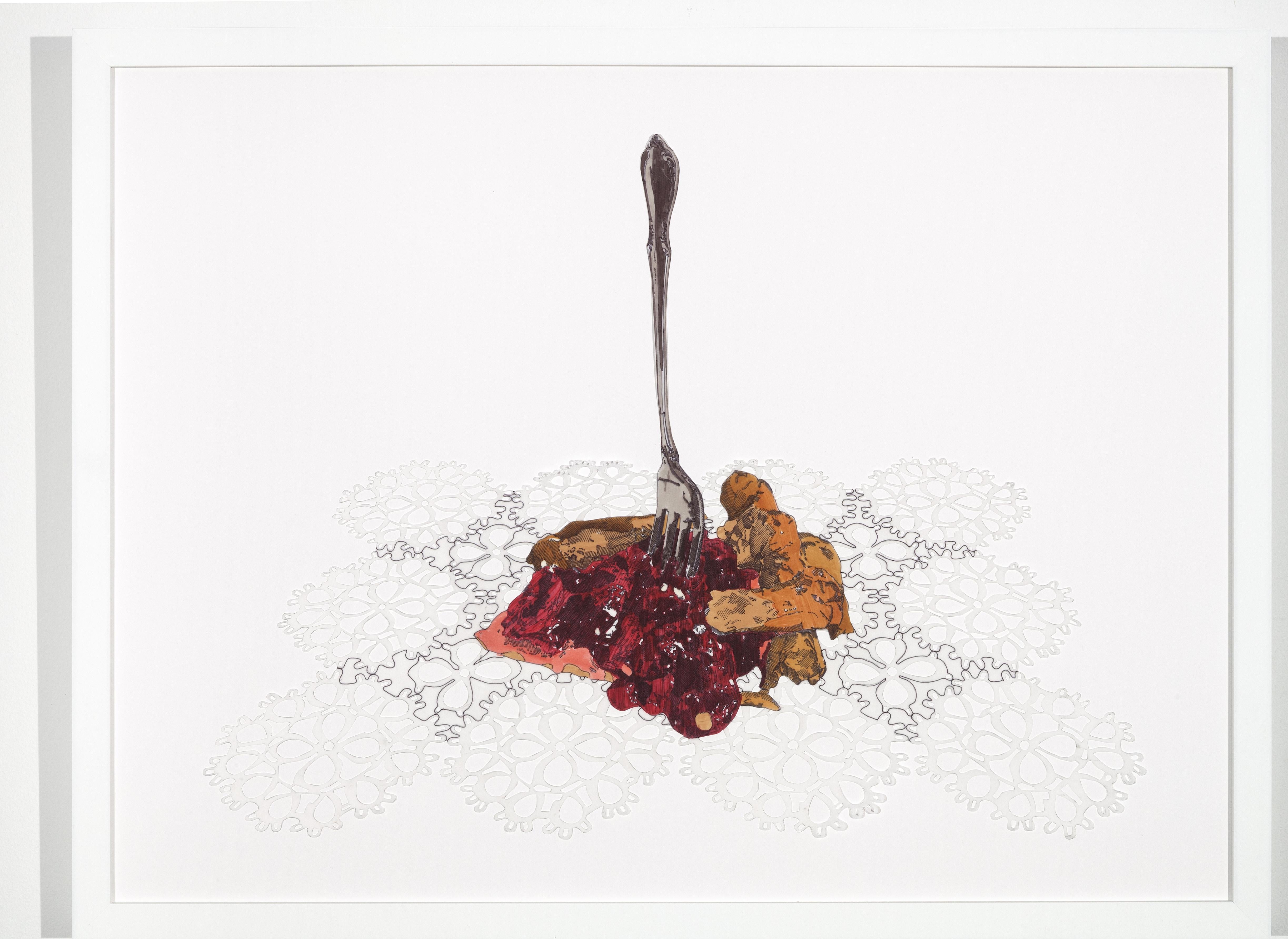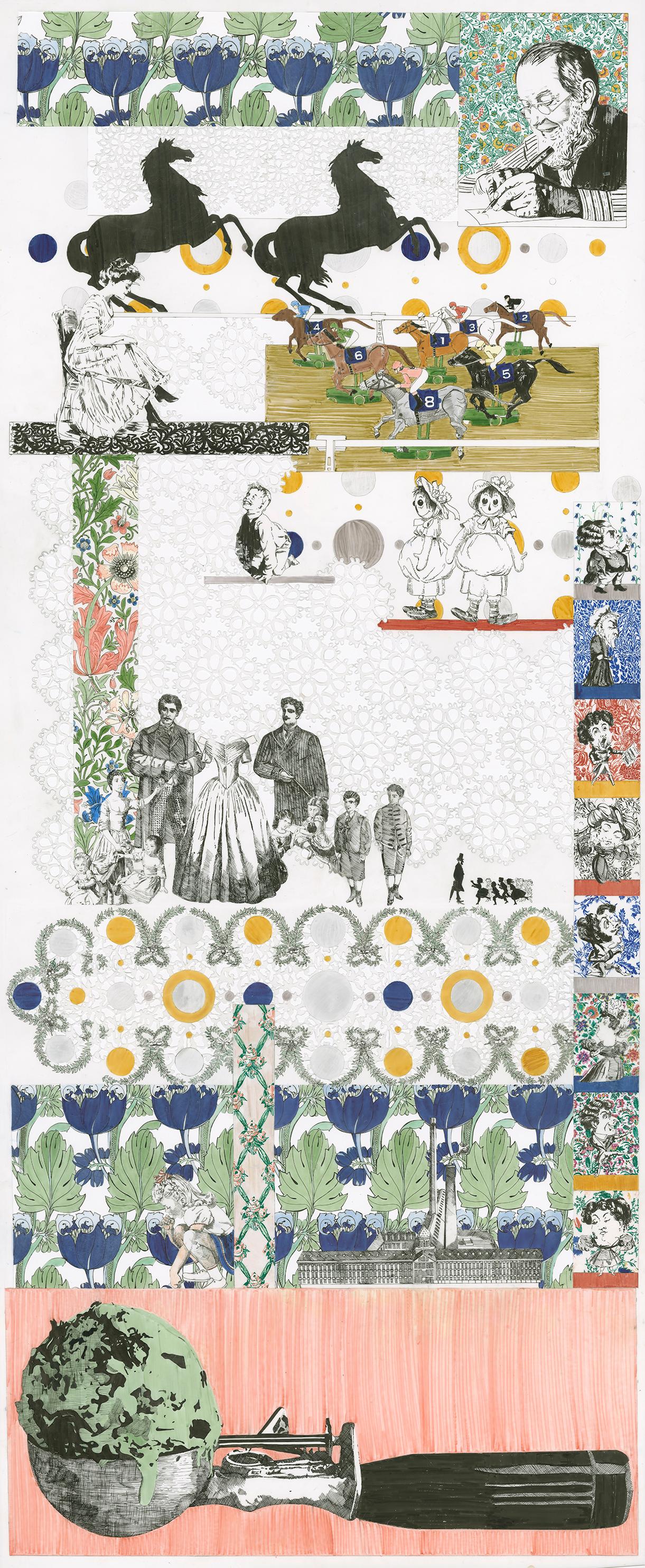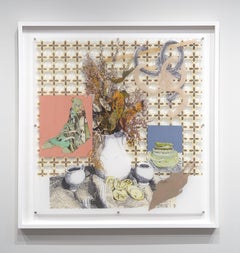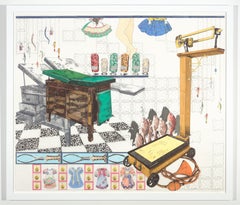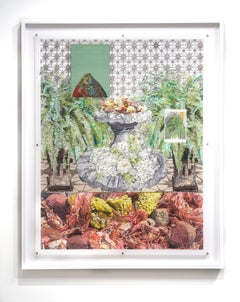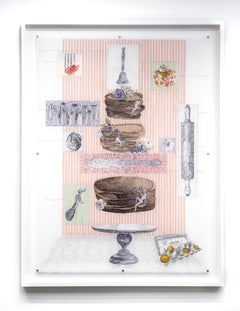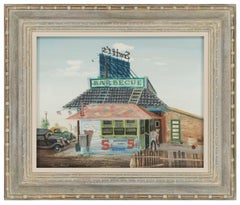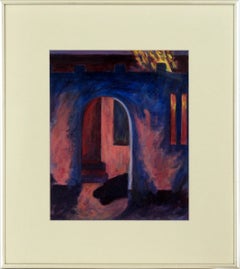Want more images or videos?
Request additional images or videos from the seller
1 of 4
Laura Tanner GrahamBarbecue Nation2019
2019
$10,000
£7,581.37
€8,739.32
CA$14,083.40
A$15,617.44
CHF 8,205.81
MX$190,818.62
NOK 102,665.86
SEK 96,369.45
DKK 65,240.73
About the Item
artwork dimensions (unframed): 59h x 41w inches
LAURA TANNER GRAHAM’s drawings and installations are often discussed as part of the Southern Gothic literary tradition, sharing similar themes with authors such as Flannery O’Connor and Eudora Welty. As a Georgia native, Graham’s work seeks to understand the ways in which pattern and printed textiles are informed by social and political movements. Her narratives are tightly bound to antebellum traditions while balancing the changing ideals of the new generation of southern society.
Graham received her MFA from the University of Illinois at Urbana-Champaign and a BFA from Florida State University. She has exhibited nationally in both group and solo exhibitions including the Weatherspoon Art Museum, the Ogden Museum of Southern Art, and the Athens Institute of Contemporary Art. She has also been a visiting artist at Tulane University and Valdosta State University. In 2016, Graham was awarded a fellowship and residency at the Ucross Foundation and the Vermont Studio Center. Graham is currently living and making work in Tucson, AZ.
STATEMENT
Firmly grounded in America’s expansive colonial history, my work interrogates how Southern culture has been idealized as “quintessential America” and the bedrock of traditional American values. Using my familiarity and position within Southern culture, I have created a new visual literacy to demonstrate how America’s nostalgia for tradition has been manipulated in an effort to isolate and disenfranchise. My drawings act as a visual archive of research that examines the consequences of American colonialism and addresses the sense of white fragility that continues to pervade Western culture. In the midst of widespread anxiety over the collective American identity, there has been a revival of many of the country’s unresolved historical battles, including contentious race relations, sexism, nativism, and an ever-growing wage gap. I employ the Americana aesthetic of the old South to parallel historical and contemporary acts of resistance to racial, economic, and gender diversity. Borrowing directly from the decorative arts, the meticulously hand-cut mylar and equally intricate drawing capitalizes on America’s propensity for nostalgia to lure the viewer into confronting injustices through the detached lens of that which has already happened.
Through a combination of appropriated and invented imagery, my work contextually constructs contemporary accounts of systemic marginalization, executed under the guise of leisure, embellishment and luxury. The dense visual language invites investigation into the textured surfaces and leads the viewer to reflect on the social textures of contemporary culture while questioning their own complicity in current social constructs. Sourcing from period- specific textiles, turn-of-the-century advertisements, campaign posters, and found family photographs, the collaged images create a singular narrative composition that document the cyclical and systemic nature of marginalization in America. The methodology with which the drawings are constructed echoes historical layers of rules, regulations and hierarchies that are stitched into dominant white American myths. The resulting drawings are indexical in nature, recording the parallels between topics of current debate and 18th century Western expansionism.
The disconnect between the delicate nature of the work and the unresolved cultural tensions that it reveals provides a visual record of the inconsistencies of American idealism. My current project explores the South as the embodiment of America’s pastoral traditions and values that are at the center of the “Make America Great Again” movement, a movement which has both exploited and is at odds with a social ideal that simultaneously proclaims itself to be “post- racial” and “post- gender” while identifying with a “pull-yourself-up-by-the-boot-straps” mentality. As one of the earliest colonized areas, the South is often portrayed as a region of racial and gender stability in the face of impending change. I am currently working with research institutions in the South to further understand how the architectural structure of the Southern plantation helped to build the current social structure of America.
- Creator:Laura Tanner Graham (1987, American)
- Creation Year:2019
- Dimensions:Height: 68 in (172.72 cm)Width: 49.25 in (125.1 cm)
- Medium:
- Movement & Style:
- Period:
- Condition:
- Gallery Location:New Orleans, LA
- Reference Number:1stDibs: LU10526803082
About the Seller
5.0
Vetted Professional Seller
Every seller passes strict standards for authenticity and reliability
Established in 1998
1stDibs seller since 2015
172 sales on 1stDibs
Typical response time: <1 hour
- ShippingRetrieving quote...Shipping from: New Orleans, LA
- Return Policy
Authenticity Guarantee
In the unlikely event there’s an issue with an item’s authenticity, contact us within 1 year for a full refund. DetailsMoney-Back Guarantee
If your item is not as described, is damaged in transit, or does not arrive, contact us within 7 days for a full refund. Details24-Hour Cancellation
You have a 24-hour grace period in which to reconsider your purchase, with no questions asked.Vetted Professional Sellers
Our world-class sellers must adhere to strict standards for service and quality, maintaining the integrity of our listings.Price-Match Guarantee
If you find that a seller listed the same item for a lower price elsewhere, we’ll match it.Trusted Global Delivery
Our best-in-class carrier network provides specialized shipping options worldwide, including custom delivery.More From This Seller
View AllSweet Tea
By Laura Tanner Graham
Located in New Orleans, LA
LAURA TANNER GRAHAM’s drawings and installations are often discussed as part of the Southern Gothic literary tradition, sharing similar themes with authors such as Flannery O’Connor and Eudora Welty...
Category
21st Century and Contemporary Contemporary Drawings and Watercolor Paint...
Materials
Mylar, Ink
Natural Lure
By Laura Tanner Graham
Located in New Orleans, LA
LAURA TANNER GRAHAM’s drawings and installations are often discussed as part of the Southern Gothic literary tradition, sharing similar themes with authors such as Flannery O’Connor and Eudora Welty. As a Georgia native, Graham’s work seeks to understand the ways in which pattern and printed textiles are informed by social and political movements. Her narratives are tightly bound to antebellum traditions while balancing the changing ideals of the new generation of southern society.
Graham received her MFA from the University of Illinois at Urbana-Champaign and a BFA from Florida State University. She has exhibited nationally in both group and solo exhibitions including the Weatherspoon Art Museum, the Ogden Museum of Southern Art, and the Athens Institute of Contemporary Art. She has also been a visiting artist at Tulane University and Valdosta State University. In 2016, Graham was awarded a fellowship and residency at the Ucross Foundation and the Vermont Studio Center. Graham is currently living and making work in Tucson, AZ.
STATEMENT
Firmly grounded in America’s expansive colonial history, my work interrogates how Southern culture has been idealized as “quintessential America” and the bedrock of traditional American values. Using my familiarity and position within Southern culture, I have created a new visual literacy to demonstrate how America’s nostalgia for tradition has been manipulated in an effort to isolate and disenfranchise. My drawings act as a visual archive of research that examines the consequences of American colonialism and addresses the sense of white fragility that continues to pervade Western culture. In the midst of widespread anxiety over the collective American identity, there has been a revival of many of the country’s unresolved historical battles, including contentious race relations, sexism, nativism, and an ever-growing wage gap. I employ the Americana aesthetic of the old South to parallel historical and contemporary acts of resistance to racial, economic, and gender diversity. Borrowing directly from the decorative arts, the meticulously hand-cut mylar and equally intricate drawing capitalizes on America’s propensity for nostalgia to lure the viewer into confronting injustices through the detached lens of that which has already happened.
Through a combination of appropriated and invented imagery, my work contextually constructs contemporary accounts of systemic marginalization, executed under the guise of leisure, embellishment and luxury. The dense visual language invites investigation into the textured surfaces and leads the viewer to reflect on the social textures of contemporary culture while questioning their own complicity in current social constructs. Sourcing from period- specific textiles, turn-of-the-century advertisements, campaign posters, and found family photographs, the collaged images create a singular narrative composition that document the cyclical and systemic nature of marginalization in America. The methodology with which the drawings are constructed echoes historical layers of rules, regulations and hierarchies that are stitched into dominant white American myths. The resulting drawings are indexical in nature, recording the parallels between topics of current debate and 18th century Western expansionism.
The disconnect between the delicate nature of the work and the unresolved cultural tensions that it reveals provides a visual record of the inconsistencies of American idealism. My current project explores the South as the embodiment of America’s pastoral traditions and values that are at the center of the “Make America Great Again” movement, a movement which has both exploited and is at odds with a social ideal that simultaneously proclaims itself to be “post- racial” and “post- gender” while identifying with a “pull-yourself-up-by-the-boot-straps” mentality. As one of the earliest colonized areas, the South is often portrayed as a region of racial and gender stability in the face of impending change. I am currently working with research institutions in the South to further understand how the architectural structure of the Southern plantation...
Category
21st Century and Contemporary Contemporary Drawings and Watercolor Paint...
Materials
Mylar, Ink
Lola I
By Laura Tanner Graham
Located in New Orleans, LA
LAURA TANNER GRAHAM’s drawings and installations are often discussed as part of the Southern Gothic literary tradition, sharing similar themes with authors such as Flannery O’Connor and Eudora Welty...
Category
21st Century and Contemporary Contemporary Drawings and Watercolor Paint...
Materials
Mylar, Ink
Three Tier
By Laura Tanner Graham
Located in New Orleans, LA
LAURA TANNER GRAHAM’s drawings and installations are often discussed as part of the Southern Gothic literary tradition, sharing similar themes with authors such as Flannery O’Connor and Eudora Welty...
Category
21st Century and Contemporary Contemporary Drawings and Watercolor Paint...
Materials
Mylar, Ink
P.O.P. (Piece of Pie)
By Laura Tanner Graham
Located in New Orleans, LA
artwork dimensions (unframed): 15h x 20w inches
LAURA TANNER GRAHAM’s drawings and installations are often discussed as part of the Southern Gothic literary tradition, sharing similar themes with authors such as Flannery O’Connor and Eudora Welty. As a Georgia native, Graham’s work seeks to understand the ways in which pattern and printed textiles are informed by social and political movements. Her narratives are tightly bound to antebellum traditions while balancing the changing ideals of the new generation of southern society.
Graham received her MFA from the University of Illinois at Urbana-Champaign and a BFA from Florida State University. She has exhibited nationally in both group and solo exhibitions including the Weatherspoon Art Museum, the Ogden Museum of Southern Art, and the Athens Institute of Contemporary Art. She has also been a visiting artist at Tulane University and Valdosta State University. In 2016, Graham was awarded a fellowship and residency at the Ucross Foundation and the Vermont Studio Center. Graham is currently living and making work in Tucson, AZ.
STATEMENT
Firmly grounded in America’s expansive colonial history, my work interrogates how Southern culture has been idealized as “quintessential America” and the bedrock of traditional American values. Using my familiarity and position within Southern culture, I have created a new visual literacy to demonstrate how America’s nostalgia for tradition has been manipulated in an effort to isolate and disenfranchise. My drawings act as a visual archive of research that examines the consequences of American colonialism and addresses the sense of white fragility that continues to pervade Western culture. In the midst of widespread anxiety over the collective American identity, there has been a revival of many of the country’s unresolved historical battles, including contentious race relations, sexism, nativism, and an ever-growing wage gap. I employ the Americana aesthetic of the old South to parallel historical and contemporary acts of resistance to racial, economic, and gender diversity. Borrowing directly from the decorative arts, the meticulously hand-cut mylar and equally intricate drawing capitalizes on America’s propensity for nostalgia to lure the viewer into confronting injustices through the detached lens of that which has already happened.
Through a combination of appropriated and invented imagery, my work contextually constructs contemporary accounts of systemic marginalization, executed under the guise of leisure, embellishment and luxury. The dense visual language invites investigation into the textured surfaces and leads the viewer to reflect on the social textures of contemporary culture while questioning their own complicity in current social constructs. Sourcing from period- specific textiles, turn-of-the-century advertisements, campaign posters, and found family photographs, the collaged images create a singular narrative composition that document the cyclical and systemic nature of marginalization in America. The methodology with which the drawings are constructed echoes historical layers of rules, regulations and hierarchies that are stitched into dominant white American myths. The resulting drawings are indexical in nature, recording the parallels between topics of current debate and 18th century Western expansionism.
The disconnect between the delicate nature of the work and the unresolved cultural tensions that it reveals provides a visual record of the inconsistencies of American idealism. My current project explores the South as the embodiment of America’s pastoral traditions and values that are at the center of the “Make America Great Again” movement, a movement which has both exploited and is at odds with a social ideal that simultaneously proclaims itself to be “post- racial” and “post- gender” while identifying with a “pull-yourself-up-by-the-boot-straps” mentality. As one of the earliest colonized areas, the South is often portrayed as a region of racial and gender stability in the face of impending change. I am currently working with research institutions in the South to further understand how the architectural structure of the Southern plantation...
Category
21st Century and Contemporary Contemporary Drawings and Watercolor Paint...
Materials
Mylar, Ink
Low Front IV
By Laura Tanner Graham
Located in New Orleans, LA
[Tucson, AZ ::: b. 1987, Atlanta, GA]
LAURA TANNER GRAHAM's drawings and installations are often discussed as part of the Southern Gothic literary tradition, sharing similar themes ...
Category
21st Century and Contemporary Contemporary Drawings and Watercolor Paint...
Materials
Mylar, Ink
You May Also Like
Gouache on Board Painting Titled "Barbecue Stand", by Aaron Bohrod, circa 1935
By Aaron Bohrod
Located in New York, NY
Aaron Bohrod, 1907-1992
Barbecue Stand, circa 1935
Gouache on board
Signed Lower left: “Aaron Bohrod”
Inscribed and signed on verso
Bohrod-1
Provenance:
Private estate, Rhode Island...
Category
1930s Figurative Paintings
Materials
Gouache
Food Chain, Surrealist Pencil and Watercolor on Paper by James Meyer
By James Meyer
Located in Long Island City, NY
Artist: James Meyer
Title: Food Chain
Year: 1990
Medium: Watercolor Tusche and Pencil on Paper, signed
Size: 29.5 x 34.5 inches (74.93 x 87.63 cm)
Frame: 38...
Category
1990s Contemporary Figurative Drawings and Watercolors
Materials
Paper, Watercolor, Pencil
'Love Garden Party (Picnic #1), ' by Skip Hill, Mixed Media on Vellum, 2019
Located in Oklahoma City, OK
'Love Garden Party (Picnic #1)' is an original mixed-medium work of art composed of high quality acrylic paint, opaque, metallic and neon inks, hand-cut collage, sealed with satin varnish on 36"h x 23.875"w on cold press paper stock. The painting is framed (41.5"h x 29.5”w) with conservation quality, high UV-filtering museum glazing. Signed by the artist. Part of Skip Hill's 'Love Garden Party' series, this work depicts four women gathered around a festive table filled with food and drink with a myriad of disparate objects including masks, Asian porcelain, and flowers.
Skip Hill was born in 1961 in Padre Island, Texas but grew up primarily in Oklahoma City. After attending Oklahoma City University to study Advertising and Marketing, he worked as a graphic designer before relocating in 1987 to Southern California. A two-week trip to Thailand in 1989 turned into a year traveling throughout Southeast Asia while writing for a business magazine based in Bangkok. In 1990 Skip Hill relocated to the Netherlands, immersing himself in the culture and learning the Dutch language. His frequent visits the Van Gogh Museum, the Stedelijk Museum and The Rijksmuseum in Amsterdam as well as the Boijman Van Beuningen Museum in Rotterdam, sparked Hill’s interest in creating art inspired by aesthetic concerns over the strictly commercial art he produced during his advertising career. It was during this time abroad that he traveled through Germany, Czechoslovakia and Morocco. After returning to Oklahoma in 1993, Skip Hill studied formally at The University of Oklahoma with conceptual artist Hachivi Edgar Heap of Birds, and influential abstract painter George Bogart...
Category
21st Century and Contemporary Contemporary Mixed Media
Materials
Ink, Mixed Media, Acrylic, Ballpoint Pen
$8,000 Sale Price
20% Off
"Barbeque Study II" - Acrylic on Paper
Located in Soquel, CA
Interior courtyard scene by Santa Cruz, California artist Betsy J. Miller (American, b. 1956). This piece is a part of the artist's series of "Site Portraits." An arched doorway in a...
Category
1980s Contemporary Interior Paintings
Materials
Paper, Acrylic
Da Vinci's Restaurant, Lithograph by Lester Johnson
By Lester Johnson
Located in Long Island City, NY
Artist: Lester Johnson
Title: DaVinci's Restaurant
Year: 1980
Medium: Lithograph, signed and numbered in pencil
Edition: 150
Paper Size: 28 x 21 inches
Category
1980s Contemporary Figurative Prints
Materials
Lithograph
Reanimator
Located in Columbia, MO
Sean Lyman is a Professor of Painting and Drawing at Missouri State University, with an extensive list of international exhibitions and work in public permanent collections including...
Category
21st Century and Contemporary American Realist Interior Drawings and Wat...
Materials
Archival Paper, Graphite, Watercolor
More Ways To Browse
American Gothic Painting
Plantation Painting
18th Century Colonial Paintings
Southern Gothic
Race Relations
American 19th Century Watercolors
Pen And Ink French
Native American Pastels
Mid Century Sketch Pencil
Watercolor On Silk
Fish Watercolor
Pencil Drawings Of Flowers
Black Ink Line Drawing
Antique Drawing Board
Pencil Geometric Drawing
Watercolour Painting Of Cat
Antique Ink Stamps
Cottage Watercolours
